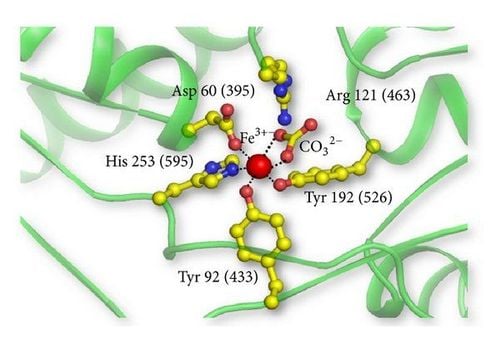This is an automatically translated article.
Lactoferrin is one of many naturally occurring proteins found in human and cow's milk. In addition, this protein is also found in many other body fluids such as saliva, tears... In this article, the most basic knowledge about Lactoferrin will be provided to readers.1. What is Lactoferrin - understanding Lactoferrin protein
Lactoferrin is a large molecular weight protein whose main function is to bind iron and transport it throughout the body. Besides, Lactoferrin has also proven many other roles for health such as preventing cancer risk, improving resistance, anti-aging and improving osteoporosis in the elderly...
Lactoferrin có nồng độ cao nhất trong sữa non và giảm dần đến 9 tháng thì mất hoàn toàn
2. Where is Lactoferrin protein found?
The protein Lactoferrin is found in abundance in the milk of mammals. In particular, colostrum (milk from a woman who has just given birth) is the type of milk with the highest Lactoferrin content and this content will gradually decrease over time until it completely disappears. This period usually lasts about 9 months after breastfeeding. This is also one of the many reasons that babies should be breastfed for at least the first 6 months. In addition, Lactoferrin is also found in many other body fluids such as tears, saliva or bile, but at very low concentrations.3. What are the health benefits of Lactoferrin? - Synthesize the roles of Lactoferrin
3.1 Lactoferrin's effect on infection In a report published in the Journal of Infection and Chemotherapy in 2014, Lactoferrin's role was discovered in inhibiting the body's cell-binding viral activity. , thereby preventing the replication of the virus in the human body. Besides, Lactoferrin also inhibits the growth of various bacteria, including gram-negative, gram-positive bacteria, aerobic and anaerobic bacteria or other harmful microorganisms such as fungi, parasites, viruses...
The mechanism of inhibition of Lactoferrin infection is explained by the positive charge of Lactoferrin. These positive charges will bind with the negative charge on the surface of the bacterial cell, thereby neutralizing the charge. This is the condition that helps lysozyme destroy bacteria through the cell membrane. In addition, Lactoferrin can also bind to GAGs with the effect of preventing the virus from attaching to host cells. This is the mechanism that helps Lactoferrin affect many different viruses such as HIV, hepatitis B virus, herpes virus or CMV...
3.2 Does Lactoferrin work for hepatitis C? Some recent studies show that Lactoferrin has the ability to inhibit the process of hepatitis C infection in the body. Specifically, a 2013 study in Hepatology Research found that treatment with the drug Lactoferrin can boost levels of interleukin-18 - a protein in the immune system that plays an important role in fighting inflammation. hepatitis C. This is a study conducted on 63 people infected with the virus with a duration of more than 1 year.
However, there are still many other data that show conflicting about the ability of hepatitis C virus to enter Lactoferrin target cells, so this is still a matter of requiring more evidence.

Thuốc Lactoferrin có thể được ứng dụng trong điều trị viêm gan C
3.3 Improve Acne and Skin Infections with Lactoferrin A study published in the journal Nutrition in 2010 was conducted by having participants consume fermented milk with about 200mg of Lactoferrin daily for 12 weeks, and the results showed that acne-related lesions were significantly improved month by month.
At the end of the study period, the group of people who used milk with Lactoferrin had significantly reduced the number of acne, inflammatory foci and also the amount of sebum secreted on the skin. In particular, the researchers noticed a reduction in the concentration of triacylglycerol - a type of fat - on the surface of the skin.
Another 2017 study also determined that the combined use of Lactoferrin with vitamin E and zinc for 3 months improved a wide range of mild to moderate acne-related problems. At the same time, the number of lesions due to acne and acne, inflammation on the skin is also reduced.
3.4 Lactoferrin in improving osteoporosis Research studies on the benefits of Lactoferrin for bone are still relatively limited. However, some preliminary research suggests that this is a potential substance in supporting and preventing osteoporosis problem.
Specifically, according to a 2015 report in PLoS One, laboratory tests have found that Lactoferrin can work together with hydroxyapatite to stimulate the growth of osteoblasts (bone-forming cells). In addition, another study in the journal Osteo System International in 2009 also found that taking the drug Lactoferrin promotes bone health in postmenopausal women. At the end of the study, those who took the Lactoferrin supplement had significantly reduced bone loss, and increased bone density.
3.5 Taking Lactoferrin to strengthen the immune system Lactoferrin is also a protein that regulates and promotes the activity of the immune system, indirectly participating in specific immune responses.
As explained by scientists, Lactoferrin proteins carry a positive charge, so they will bind with the negative charge of immune cells, thereby activating signals leading to immune responses.
3.6 Lactoferrin and the mechanism to prevent damage from aging First, Lactoferrin is a great source of protein for the body, thereby helping to nourish the cells. Besides, Lactoferrin can bind with iron, eliminate free radicals generated from iron, so effective anti-aging.
Other Roles of Lactoferrin Protein
Promotes the healthy functioning of beneficial bacteria in the intestinal tract. Regulates iron metabolism and absorption. Prevent cancer. Simultaneous treatment of constipation, diarrhea and other digestive problems...
4. Who should use Lactoferrin?
Lactoferrin drug is suitable for most target groups. In particular, the prominent role of this protein is to enhance immune activity and reduce the risk of many diseases, so it is especially suitable for:
Children and infants. Women who are pregnant or have just given birth often have low resistance. Elderly people, people who have just recovered from illness or are suffering from diseases that weaken the immune system such as HIV/AIDS, diabetes, hepatitis B...

Trẻ em và trẻ sơ sinh là một trong các đối tượng nên sử dụng thuốc Lactoferrin
5. Appropriate dosage of Lactoferrin
Depending on age, health status as well as ability to absorb / metabolize Lactoferrin, the addition of Lactoferrin drug will have different concentrations. Specifically:
For pregnant women, every day should take about 200 - 250mg per kg of body weight, used continuously for 8 weeks. For children with sepsis, 100-200mg Lactoferrin should be added per kilogram of body per day. For patients with hepatitis C, the daily dose ranges from 1.8 to 3.6g depending on the disease condition. It can be said that Lactoferrin is a versatile protein with many important roles for health. However, the use of Lactoferrin drug requires a prescription and dosage guidance from a doctor to avoid side effects.
Please dial HOTLINE for more information or register for an appointment HERE. Download MyVinmec app to make appointments faster and to manage your bookings easily.
Reference source: fhi.vn/lactoferrin - .verywellhealth.com












